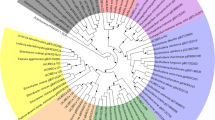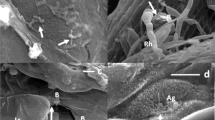Abstract
Background and aims
Endophytic and rhizospheric environments differ in many respects, leading to the presence of different bacterial communities at each site. However, microorganisms such as enterobacteria can be found both within plants and in the surrounding soil. Bacteria must present differences in the traits that affect such environments in order to successfully colonise them. The present study compared the plant growth-promoting potential of diazotrophic enterobacteria isolated from the rhizosphere and from within surface-disinfected plants.
Methods
A total of 46 diazotrophic enterobacterial strains (21 rhizospheric and 25 putatively endophytic) belonging to the Klebsiella and Enterobacter genera, which are prevalent in sugar cane plantations, were isolated from the rhizosphere and from surface-disinfected plants. Their ability to synthesise amino acids using combined nitrogen obtained from nitrogen fixation, and their ability to synthesise indole-3-acetic acid (IAA) were determined by high performance liquid chromatography. Endogenous ethylene production by the bacteria was measured using gas chromatography, and biocontrol of phytopathogenic fungi was determined qualitatively using a dual culture technique.
Results
The putative endophytes released significantly higher amounts of amino acids than the rhizospheric bacteria, whilst the latter produced higher quantities of ethylene and were more actively antagonistic to fungi. Both types of bacteria released similar amounts of IAA.
Conclusion
Endophytic and rhizospheric bacteria differ in their capacity to release plant growth-promoting substances, which may be a reflection of their adaptations and an indication of their potential impact on their natural environment.

Similar content being viewed by others
Abbreviations
- IAA:
-
Indole-3-acetic Acid
References
Ahmad F, Ahmad I, Khan MS (2008) Screening of free-living rhizospheric bacteria for their multiple plant growth promoting activities. Microbiol Res 163:173–181
Alves BJR, Boddey RM, Urquiaga S (2003) The success of BNF in soybean in Brazil. Plant Soil 252:1–9
Araújo WL, Marcon J, Maccheroni W Jr, Van Elsas JD, Van Vuurde JWL, Azevedo JL (2002) Diversity of endophytic bacterial populations and their interation with Xylella fastidiosa in citrus plants. Appl Environ Microbiol 68:4906–4914
Astarita LV, Floh EIS, Handro W (2003) Changes in IAA, tryptophan and activity of soluble peroxidase associated with zygotic embryogenesis in Araucaria angustifolia (Brazilian pine). Plant Growth Regul 39:113–118
Backman PA, Sikora RA (2008) Endophytes: an emerging tool for biological control. Biol Control 46:1–3
Berg G (2009) Plant-microbe interactions promoting plant growth and health: perspectives for controlled use of microorganisms in agriculture. Appl Microbiol Biotechnol 84:11–18
Brimecombe MJ, De Lelj FA, Lynch JM (2001) The effect of root exudates on rhizosphere microbial populations. In: Pinton R, Varanini Z, Nannipieri P (eds) The rhizosphere. Biochemistry and organic substances at the soil-plant interface. Dekker, New York, pp 95–140
Chanway CP, Shishido M, Nairn J, Jungwirth S, Markham J, Xiao G, Holl FB (2000) Endophytic colonization and field response of hybrid spruce seedlings after inoculation with plant growth-promoting rhizobacteria. For Ecol Manag 133:81–88
Chelius MK, Triplett EW (2000) Immunolocalization of Dinitrogenase Reductase Produced by Klebsiella pneumoniae in Association with Zea mays. Lett Appl Environ Microbiol 66:783–787
Compant S, Reiter B, Sessitsch A, Nowak J, Clément C, Ait-Barka E (2005) Endophytic colonization of Vitis vinifera L. by plant growth-promoting bacterium Burkholderia sp. strain PsJN. Appl Environ Microbiol 71:1685–1693
Dobbelaere S, Croonenborghs A, Thys A, Van de Broek A, Vanderleyden J (1999) Phytostimulatory effect of Azospirillum brasilense wild type and mutant strains altered in IAA production on wheat. Plant Soil 212:155–164
Döbereiner J (1980) Forage grasses and grain crops. In: Bergersen FJ (ed) Methods for evaluating biological nitrogen. Wiley, New York, pp 535–555
Donate-Correa J, Barrios ML, Galdona RP (2004) Screening for plant growth-promoting rhizobacteria in Chamaecytisus proliferus (tagasaste), a forage tree-shrub legume endemic to the Canary Islands. Plant Soil 266:75–84
Fageria NK, Stone LF (2006) Physical, chemical, and biological changes in the rhizosphere and nutrient availability. J Plant Nutr 29:1327–1356
Glick BR, Cheng Z, Czarny J, Duan J (2007) Promotion of plant growth by ACC deaminase-producing soil bacteria. Eur J Plant Pathol 119:329–339
Govindarajan M, Kwon SW, Weon HY (2007) Isolation, molecular characterization and growth-promoting activities of endophytic sugarcane diazotroph Klebsiella sp. GR9. World J Microbiol Biotechnol 23:997–1006
Govindarajan M, Balandreau J, Kwon SW, Weon HY, Lakshminarasimhan C (2008) Effects of the inoculation of Burkholderia vietnamensis and related endophytic diazotrophic Bacteria on grain yield of rice. Microb Ecol 55:21–37
Grichko VP, Glick BR (2001) Ethylene and flooding stress in plant. Plant Physiol Biochem 39:1–9
Gyaneshwar P, James EK, Mathan N, Reddy PM, Reinhold-Hurek B, Ladha JK (2001) Endophytic colonization of rice by a diazotrophic strain of Serratia marcescens. J Bacteriol 183:2634–2645
Hallmann J, Berg B (2007) Spectrum and population dynamics of bacterial root endophytes. In: Schulz BJE, Boyle CJC, Sieber TN (eds) Microbial root endophytes. Springer, Berlin, pp 15–31
Han J, Sun L, Dong X, Cai Z, Yang H, Wang Y, Song W (2005) Characterization of a novel plant growth-promoting bacteria strain Delftia tsuruhatensis HR4 both as a diazotroph and a potential biocontrol agent against various pathogens. Syst Appl Microbiol 28:66–76
Iniguez AL, Dong Y, Triplett EW (2004) Nitrogen fixation in wheat provided by Klebsiella pneumoniae 342. Mol Plant Microbe Interact 17:1078–1085
James EK (2000) Nitrogen fixation in endophytic and associative symbiosis. Field Crop Res 65:197–209
Jorquera MA, Hernández MT, Rengel Z, Marschner P, Mora ML (2008) Isolation of culturable phosphobacteria with both phytate-mineralization and phosphate-solubilization activity from the rhizosphere of plants grown in a volcanic soil. Biol Fertil Soils 44:1025–1034
Karthikeyan M, Bhaskaran R, Radhika K, Mathiyazhagan S, Jayakumar V, Sandosskumar R, Velazhahan R (2005) Endophytic Pseudomonas fluorescens Endo2 and Endo35 induce resistance in black gram (Vigna mungo L. Hepper) to the pathogen Macrophomina phaseolina. J Plant Interact 1:135–143
Kennedy IR, Choudhury ATMA, Kecskés ML (2004) Non-symbiotic bacterial diazotrophs in crop-farming systems: can their potential for plant growth promotion be better exploited? Soil Biol Biochem 36:1229–1244
Khan Z, Doty SL (2009) Characterization of bacterial endophytes of sweet potato plants. Plant Soil 322:197–207
Lacava PT, Araújo WL, Marcon J, Maccheroni W Jr, Azevedo JL (2004) Interaction between endophytic bacteria from citrus plants and the phytopathogenic bacteria Xylella fastidiosa, causal agent of citrus-variegated chlorosis. Lett Appl Microbiol 39:55–59
Lauzon CR, Mccombs SD, Potter SE, Peabody NC (2009) Establishment and vertical passage of Enterobacter (Pantoea) Agglomerans and Klebsiella pneumoniae through all life stages of the Mediterranean fruit fly (Diptera: Tephritidae). Ann Entomol Soc Am 102:85–95
Li Y, Solomon S (2003) Ethephon: a versatile growth regulator for sugarcane industry. Sugar Tech 5:213–223
Miché L, Battistoni F, Gemmer S, Belghazi M, Reinhold-Hurek B (2006) Upregulation of jasmonate-inducible defense proteins and differential colonization of roots of Oryza sativa cultivars with the endophyte Azoarcus sp. Mol Plant Microbe Interact 19:502–511
Morgan JAW, Bending GD, White PJ (2005) Biological costs and benefits to plant–microbe interactions in the rhizosphere. J Exp Bot 56:1729–1739
Murashige T, Skoog F (1962) A revised medium for rapid growth and bioassays with Tobacco tissue cultures. Physiol Plant 15:473–497
Oliveira ZM, Floh EIS, Ferrara FIS, Barbosa HR (2011) Diazotrophyc rhizobacteria isolated from sugarcane can release amino acids in a synthetic culture medium. Biol Fertil Soil 47:957–962
Pal KK, Tilak KVBR, Saxena AK, Dey R, Singh CS (2001) Suppression of maize root diseases caused by Macrophomina phaseolina, Fusarium moniliforme and Fusarium graminearum by plant growth promoting rhizobacteria. Microbiol Res 156:209–223
Pariona-Llanos R, Ferrara FIS, Soto HH, Barbosa HR (2010) Influence of organic fertilization on the number of culturable diazotrophic endophytic bactéria isolated from sugarcane. Eur J Soil Biol 46:387–393
Persello-Cartieaux F, Nussaume L, Robaglia C (2003) Tales from the underground: molecular plant-rhizobacteria interactions. Plant Cell Environ 26:189–199
Pierik R, Tholen D, Poorter H, Visser EJW, Voesenek LACJ (2006) The Janus face of ethylene: growth inhibition and stimulation. Trends Plant Sci 11:176–183
Ramakrishna BS (2007) The normal bacterial flora of the human intestine and its regulation. J Clin Gastroenterol 41:S2–S6
Raupach GS, Liu L, Murphy JF, Tuzun S, Kloepper JW (1996) Induced systemic resistance in cucumber and tomato against cucumber mosaic cucumovirus using plant growth-promoting rhizobacteria (PGPR). Plant Dis 80:891–894
Renwick AR, Campbell A, Coe S (1991) Assessment of in vivo screening systems for potential biocontrol agents of Gaeumannomyces graminis. Plant Physiol 40:524–532
Rodriguez H, Fraga R (1999) Phosphate solubilizing bacteria and their role in plant growth promotion. Biotechnol Adv 17:319–339
Roesch LFW, Camargo FAO, Bento FM, Triplett EW (2007a) Biodiversity of diazotrophic bacteria within the soil, root and stem of field-grown maize. Plant Soil 302:91–104
Roesch LFW, Quadros PD, Camargo FAO, Triplett EW (2007b) Screening of diazotrophic bacteria Azopirillum spp. for nitrogen fixation and auxin production in multiple field sites in southern Brazil. World J Microbiol Biotechnol 23:1377–1383
Rosenblueth M, Martínez-Romero E (2006) Bacterial endophytes and their interactions with hosts. Mol Plant Microbe Interact 19:827–837
Sharma A, Johri BN, Sharma AK, Glick BR (2003) Plant growth promoting bacterium Pseudomonas sp., strain GFP(3) influences iron acquisition in mung bean (Vigna radiate L. Wilzeck). Soil Biol Biochem 35:887–894
Sheng X, Chen X, He L (2008) Characteristics of an endophytic pyrene-degrading bacterium of Enterobacter sp. 12 J1 from Allium macrostemon Bunge. Int Biodeterior Biodegrad 62:88–95
Shoebitz M, Ribaudo CM, Pardo MA, Cantore ML, Ciampi L, Curá JA (2009) Plant growth promoting properties of a strain of Enterobacter ludwigii isolated from Lolium perenne rhizosphere. Soil Biol Biochem 41:1768–1774
Spaepen S, Vanderleyden J, Remans R (2007) Indole-3-acetic acid in microbial and microorganism-plant signaling. FEMS Microbiol Rev 31:425–448
Thuler DS, Floh EIS, Handro W, Barbosa HR (2003a) Plant growth regulators and amino acids released by Azospirillum sp. in chemically defined media. Lett Appl Microbiol 37:174–178
Thuler DS, Floh EIS, Handro W, Barbosa HR (2003b) Beijerinckia derxii releases plant growth regulators and amino acids in synthetic media independent of nitrogenase activity. J Appl Microbiol 95:799–806
Wang R, Wu S, Li X, He, Liu Y (2009) Detection of AmpC β-lactamase and drug resistance of Enterobacter cloacae. Front Med China 3:72–75
Weyens N, van der Lelie D, Taghavi S, Newman L, Vangronsveld J (2009) Exploiting plant–microbe partnerships to improve biomass production and remediation. Trends Biotechnol 27:591–598
White J, Prell J, James EK, Poole P (2007) Nutrient sharing between symbionts. Plant Physiol 144:604–614
Wood CC, Islam N, Ritchie RJ, Kennedy IR (2001) A simplified model for assessing critical parameters during associative 15 N2 fixation between Azospirillum and wheat. Aust J Plant Physiol 28:969–974
Wyse RE, Komor E (1984) Mechanism of amino acid uptake by sugarcane suspension cells. Plant Physiol 76:865–870
Xie H, Pasternak JJ, Glick BR (1996) Isolation and characterization of mutants of the plant growth-promoting rhizobacterium Pseudomonas putida CR12-2 that overproduce indoleacetic acid. Curr Microbiol 32:67–71
Yim WJ, Poonguzhali S, Madhaiyan M, Palaniappan P, Siddikee MA, Sa T (2009) Characterization of plant-growth promoting diazotrophic bacteria isolated from field grown Chinese cabbage under different fertilization conditions. J Microbiol 47:147–155
Acknowledgements
The authors wish to thank Fundação de Amparo à Pesquisa do Estado de São Paulo for grants and fellowships, Fazenda São Francisco for kindly providing the sugar cane samples, Dr. Marcel Bouquet for volunteering his many skills in translating this paper and Mrs. Rosana Prisco for the statistical analyses of the data.
Author information
Authors and Affiliations
Corresponding author
Additional information
Responsible Editor: Euan K. James.
Rights and permissions
About this article
Cite this article
de Santi Ferrara, F.I., Oliveira, Z.M., Gonzales, H.H.S. et al. Endophytic and rhizospheric enterobacteria isolated from sugar cane have different potentials for producing plant growth-promoting substances. Plant Soil 353, 409–417 (2012). https://doi.org/10.1007/s11104-011-1042-1
Received:
Accepted:
Published:
Issue Date:
DOI: https://doi.org/10.1007/s11104-011-1042-1




